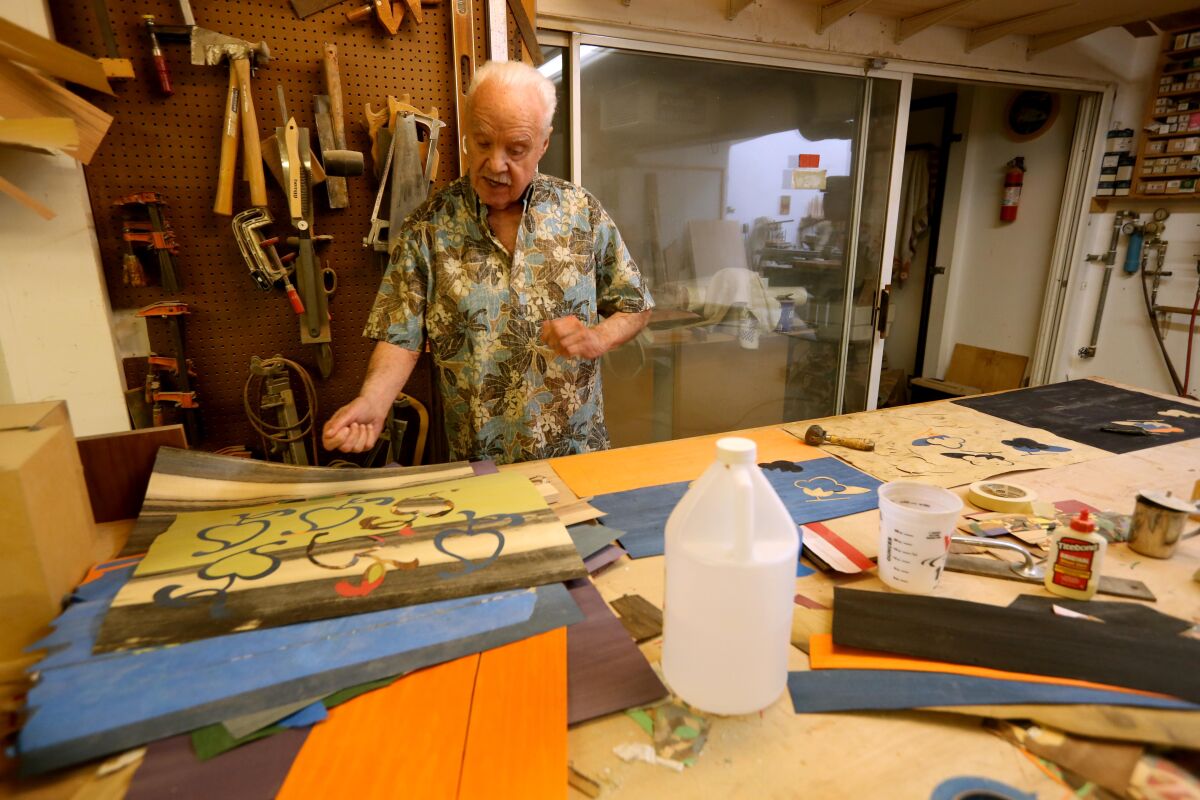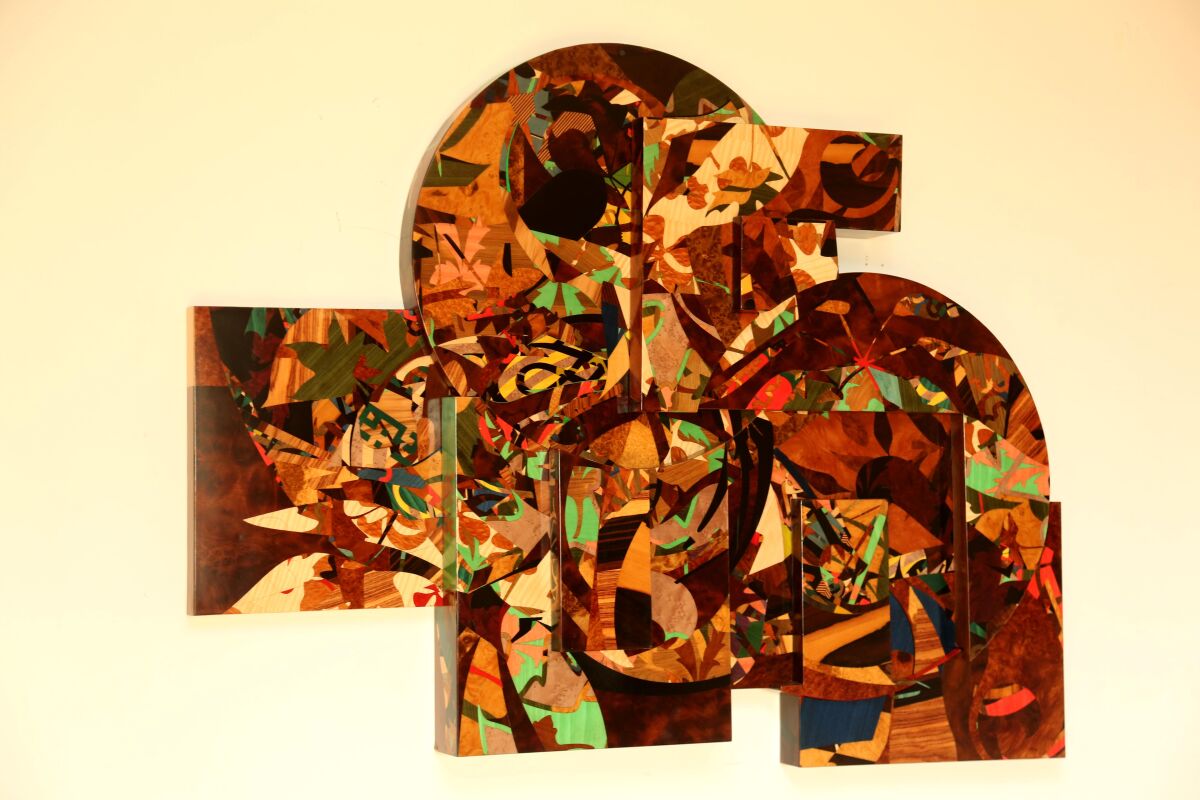On a warm morning in August, William Tunberg sits across from his wife, Camille, at a glass coffee table. The modern piece of furniture presents a stark contrast to the other effects around the house: brightly hued trinket wooden boxes are neatly arranged on the dining table; sculptural forms in different shades of wood adorn the walls; and a large fruit bowl carved from timber balances precariously on the glass countertop. On closer inspection, small pieces of brightly colored veneer dance from these wooden forms, paying homage to the art form Tunberg has spent a lifetime perfecting: marquetry.
It wasn’t always his preferred medium. Tunberg hails from a family of writers — his father, William Tunberg, wrote the screenplay for “Old Yeller” and his uncle Karl Tunberg, also a screenwriter, was nominated for an Academy Award for “Ben-Hur.” Yet Tunberg always wanted to be an artist. As a child, he copied postage stamps and artwork he found in magazines. He painted landscapes of Oregon, where his grandparents raised him, inspired by the works of de Chirico, Picasso and Magritte in high school. His love of human portraits was kindled by the French painter Ingres, whose influence became “an irrepressible force in my life,” Tunberg says.
After graduating from USC in 1965, Tunberg put down roots in Venice, Calif., opening a studio that counted Jim Morrison, Ben Talbert and Wallace Berman as his neighbors. Eventually, he became a life drawing instructor at colleges in Oregon and California.
A pair of wooden marquetry cubes, created by 86-year-old artist William Tunberg, rest on a living room table in his home.
(Genaro Molina/Los Angeles Times)
He also began dabbing in assemblage, a form of sculpture where ordinary objects are put together to form new pieces of art. “I was captivated by the narrative quality of this art form,” he says, calling assemblage art a three-dimensional extension of surrealism.
As the space for assemblage became crowded in the 1980s, Tunberg started looking for ways to make his art stand out. He turned to marquetry, a dying art form, to give his assemblages a fresh look. Tunberg found himself especially drawn to the form because “no one was doing it” and because it was “not something that was spontaneous.”
Marquetry, which developed in the mid-1500s as a sophisticated art form in Italy, uses pieces of wood veneers placed together by hand to form distinct designs. The craft became popular in France in the 17th century, where floral marquetry patterns dominated furniture during the reign of Louis XIV. Some of these ancient techniques, including the use of a chevalet de marqueterie, a tool to cut through veneer, are used in classes taught at the École Boulle in Paris and at the American School of French Marquetry in San Diego.
As Tunberg became obsessed with marquetry, he studied ancient techniques, including the use of horse hoof glue to combine pieces of veneer. He then started thinking about how he could modernize them.
“I found out that old marquetry takes constant care. It’s always cracking and moving around,” Tunberg says. “I had to find a way to make it a little more tougher, more resilient, so I’ve found techniques and glues and ways that I can use that no one is doing.”

An Egypt chair, created by William Tunberg, sits in his home in Venice.
(Genaro Molina/Los Angeles Times)
By the end of the ’80s, marquetry had become his dominant medium. For Tunberg, the art form is “unrivaled for beauty and visual drama, and it is extremely difficult to use in fine art sculpture.”
Tunberg’s designs start with a drawing, which he then converts to a vector file on a computer. Brows furrowed, he drags the mouse across the bright screen to layer a curvilinear drawing of a blossom atop another and hits a button. The laser cutter to his right whirs to life, slicing the blossom design on slivers of plywood. Balancing it carefully on his fingertips to his workstation, Tunberg then interchanges the blossoms he just cut with different colored ones that he’d previously cut.
This process continues until he has half a dozen layers; the simple blossom has been stretched, curved and reported into an intricate, unrecognizable pattern. “I want to get very intricate and very complicated so that you don’t recognize one thing and then not see the rest of it,” he says. “The idea is to recognize sections and then make the eye move around.”

Marquetry artist William Tunberg works in his studio in Venice on Dec. 22, 2022.
(Genaro Molina/Los Angeles Times)
Sculpture, furniture, a fruit bowl and even jigsaw-puzzle-shaped storage boxes inlaid with marquetry are beautifully displayed around his home, yet no two pieces look the same. On closer inspection, Tunberg points out how the same blossom pattern, gear wheels and a lotus show up in different sculptures — he has a collection of only 50 of the drawings that he uses. These simple drawings of florals and other objects that inspire him are his base pattern, which he then manipulates into the designs.
“A lot of the drawings are repeated over and over again, because I liked them. So I’ll maybe change a size or angle or something like that,” he says. “I can bend, twist and position in such a way and then overlay something else on top of them and get something more interesting. You get a lot of substance.”
Tunberg’s work is fantasy-oriented, taking the mind on a journey of color, contour and curvature. His work is a departure from traditional static marquetry, where patterns and images are recognizable. Instead of typical elements of landscapes, Tunberg strives to bridge the decorative fine arts with marquetry bearing his own sensibilities, where observers can “try and find interesting things that are buried in there, even if you make it up yourself.”
One such piece: Tunberg’s commission by the Fish Interfaith Center at Chapman University, which involved him building an ark that protects a Torah that was smuggled to safety during the Holocaust. Wanting people to spend time scrutinizing and studying the art piece, he blended Judaism’s Ten Commandments in Hebrew in his marquetry design.
During marquetry’s golden age, in the 16th and 17th centuries, the technique was used as a decorative element for furniture. It made something like a credenza “more than a credenza,” as Tunberg explains. “It made it an object to be looked at and took you away from yourself for a period of time.” By incorporating marquetry in furniture and everyday objects like a fruit bowl, Tunberg seeks to make people have a “different identification” with the object.
“An item of use is also a piece of art so it becomes closer to you,” he says, gesturing at the dining chairs he built for the home he shares with Camille, his wife. One of the chairs is inspired by hibiscus motifs to pay homage to his father-in-law, Alfred Shaheen, credited with popularizing the aloha shirt. “That one,” he points at a chair, “I just used a veneer because when I put the two pieces of veneer together, it made a kind of animal face.” A Japanese ogi, or fan, is recognizable on a third chair.

A marquetry wall sculpture by 86-year-old marquetry artist William Tunberg hangs in his home in Venice.
(Genaro Molina/Los Angeles Times)
Camille has been instrumental in documenting Tunberg’s work, and enrolled in web design classes at a local community college to help him create a website for his pieces. The couple hope that Tunberg’s approach to marquetry woodwork will survive, despite the challenges the medium poses for future generations.
Tunberg still undertakes commissions for large commercial projects — specialty sculptures for unusual spaces, furniture, walls and religious items. Recently, he created vessels to house Chapman University’s collection of rare antiquities, including a sculptural showcase protecting a seven-volume collection of the St. John’s Bible, which was handwritten using medieval techniques of calligraphy and illumination, and a 7-foot-tall cabinet to display a 15th century Quran.
But on that warm August day, Tunberg put down the plywood and made plans with Camille to celebrate his 86th birthday with a quiet lunch from Whole Foods. Tomorrow, it’s back to creating the art he loves so dearly.


Comments are closed.